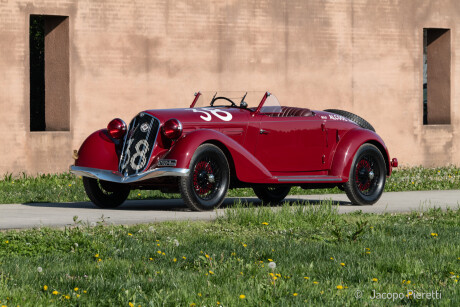
#AlfaRomeo6C2300Pescara
The model 6C 2300 Gran Turismo Pescara also only lived for one year, 1934, and derived from the Gran Turismo which had triumphed in the Targa Abruzzo of 1934. It took the name from the Scuderia Ferrari which enrolled it in the Mille Miglia, held on 14 April 1935, as a Pescara type. The light saloon was entrusted to the team of Franco Cortese and Francesco Severi, about whom there were no doubts after the previous extraordinary performance. There were another three Pescaras at the start - the private 6C 2300 of Catullo Lami from Tuscany, who took the young Pasquino Ermini with him, that of Arturo Mercanti, with his travelling companion Alessandro Gaboardi, and that of Archimede Rosa, who was partnered by the loyal Gianfranco Comotti. Only Lami's vehicle had to withdraw before Rome while Cortese and Severi finished in eighth place overall; Rosa and Comotti, also with the 2300 enrolled by Scuderia Ferrari, finished tenth and Mercanti-Gaboardi were 15th. This was a notable result which confirmed the magnificent qualities of the 6C 2300, considering that Cortese even finished ahead of some 8C 2300s and 8C 2600s and a host of supercharged 6C 1750s. Exactly twelve months after the splendid victory at the Targa Abruzzo of 1934, Scuderia Ferrari had no doubt about presenting the winning pair Franco Cortese-Francesco Severi in a 6C 2300 with light bodywork quite similar to that of the previous year created by Touring, now officially defined Pescara, at the start of the competition in August 1935. The race for Group B vehicles without superchargers was once more dominated by the two fast drivers while the other 6C driven by Archimede Rosa and Gianfranco Comotti, who had had to be happy with tenth place the year before, were placed second overall. In addition, Cortese allowed himself the luxury of considerably raise the record of the previous year, covering 2577 kilometres in the 24 hours, compared to the 2482 of the previous year. Rosa and Comotti covered 2540 kilometres. It should be noted that the fastest lap of the difficult route in Abruzzi was covered by Cortese at an average of 111.695 kph. The Pescaras also obtained excellent results in the 10th Mille Miglia, held on 5 April 1936. The new 2300 B had already been in production for some time but the robust traditional suspension with semi-elliptic springs and rigid axles of the 2300 probably offered greater guarantees. The 6C 2300 Bs finally took part in the Mille Miglia of 1937 but the traditional 2300s behaved honourably and were placed sixth, eighth and eleventh overall with the teams Franco Cortese-Angelo Guatta on board the spider with bodywork by Zagato, Edoardo Teagno-Nando Barbieri in another spider and the Randaccio brothers in the third 2300. One of the last significant results was obtained by the Zagato Spider, driven by Rodolfo Haller and Count Carlo Castelbarco, with the excellent thirteenth place overall in the Mille Miglia of 1938.
We'll tell the story of this model on the occasion of its anniversary or when it will reach a sufficient number of cars.
If you would like to share your knowledge and archive, click on the banner JOIN THE LAB - HELP US TO IMPROVE & COMPLETE THE INFORMATION.
The census of all the cars related to this topic is in progress.
CARS (1)
